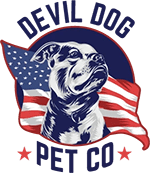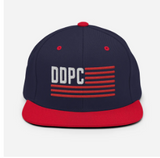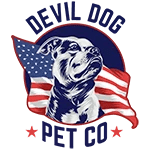The Ultimate Puppy Food Guide: Fueling Your Future Best Friend
Choosing puppy food is like selecting boot camp nutrition for a future Marine - what goes in that bowl today determines tomorrow's performance. As a dog owner who's navigated the overwhelming pet food aisles (and cleaned up the consequences of poor choices), I've learned that puppy nutrition isn't something to approach with a "whatever's on sale" mentality. Our dog Dexter taught us this lesson the hard way after a week of digestive disasters from bargain kibble. If you're raising a small pup, finding the best puppy food brand for small breeds early on can make all the difference in their lifelong health.
The right puppy food builds the foundation for your dog's entire life - from bone structure to brain development to immune function. Get it wrong, and you're potentially setting up your recruit for a lifetime of health issues. Get it right, and you're giving them the best possible start in life.
Puppy Food vs. Adult Dog Food: Why the Difference Matters

Puppies aren't just small versions of adult dogs - they're growing machines with unique nutritional requirements. Their developing bodies need significantly more protein, fat, calories, and specific nutrients than adult dogs. It's like comparing a Marine in basic training to one on weekend leave - completely different energy expenditure and building requirements.
Quality puppy food delivers approximately 22-32% protein compared to adult food's 18-25%. This isn't just marketing - it's biological necessity. Puppies are building muscle, developing organs, and growing bones at an astonishing rate. Their food needs to fuel this construction project without cutting corners.
The Critical Nutrients Your Growing Puppy Needs
- High-quality protein: Essential for muscle development and growth
- DHA (docosahexaenoic acid): Supports brain and vision development
- Balanced calcium and phosphorus: Builds proper bone structure
- Antioxidants: Strengthens developing immune systems
- Optimal calorie density: Fuels rapid growth and high energy needs
When examining puppy food labels, look for named animal proteins as the first ingredient - "chicken" or "beef" rather than vague terms like "meat meal" or "animal by-products." This isn't being picky; it's ensuring your pup gets complete, digestible protein rather than questionable leftovers.
Decoding Puppy Food Types: What's Right for Your Recruit?
Walking into a pet store today is like entering a tactical supply warehouse with endless options. Let's break down the main categories of puppy food to help you navigate this terrain. For detailed insights on balanced dog food, visit this comprehensive guide.
Dry Puppy Food (Kibble)
Kibble remains the most popular puppy dog food option for good reason. It's convenient, cost-effective, and helps promote dental health through mechanical abrasion. Premium puppy food brands like Orijen, Acana, and Taste of the Wild offer high-protein kibble with quality ingredients. The best options list real meat first and contain no artificial colors, flavors, or preservatives.
For active puppies (which is nearly all of them), dry food provides the caloric density they need without the bulk that might limit their intake. It's like an MRE - compact nutrition that delivers the goods.
Wet Puppy Food
Canned puppy food offers higher moisture content (typically 75-85% versus kibble's 10%), making it excellent for puppies that need hydration encouragement. It's generally more palatable, which helps with picky eaters or puppies transitioning from mother's milk.
The downside? It's significantly more expensive per calorie, less convenient, and doesn't provide the same dental benefits as kibble. Many owners use wet puppy food as a topper or mix it with kibble for the best of both worlds.
Fresh and Raw Options
The fresh and raw puppy food market has exploded in recent years. Companies like Farmer's Dog, Nom Nom, and Instinct offer minimally processed options delivered to your door. These foods typically contain whole ingredients you can actually recognize - real beef, sweet potatoes, carrots - rather than a list of scientific terms.
While these options align with the "feed as nature intended" philosophy, they require more handling care, storage space, and a significantly higher budget. They're the premium MREs of the dog world - excellent nutrition but at a premium price point.
Chicken-Free Puppy Food Options
Chicken is the most common protein in puppy food, but it's also a common allergen. If your puppy shows signs of food sensitivity (itching, ear infections, gastrointestinal issues), a chicken-free puppy food might be the answer. Brands like Zignature, Merrick, and Acana offer excellent puppy food beef, lamb, fish, and even exotic protein options.
These alternative protein sources aren't just for allergic pups - they often provide excellent nutrition and can be a good choice for any puppy. Just ensure the formula is specifically designed for puppies, as their nutritional needs differ from adult dogs.
Size-Specific Formulations: Why They Matter
Your puppy's adult size significantly impacts their nutritional needs during development. Think of it like training different military specialties - what works for a communications specialist won't necessarily work for front-line infantry.
Small Breed Puppy Nutrition
Small breed puppies have lightning-fast metabolisms and risk hypoglycemia if they go too long between meals. They need calorie-dense food with smaller kibble pieces suited to their tiny jaws. Top breed puppy dog food formulations for small breeds provide concentrated nutrition in manageable portions.
Brands like Royal Canin, Hill's Science Diet, and Wellness offer specialized small breed puppy formulas that account for their rapid growth and higher caloric needs per pound. These foods typically contain 350-400 calories per cup compared to large breed formulas that might contain 300-350 calories per cup.
Explore our selection for small breeds: Small Dogs Collection
Large Breed Puppy Considerations
Large and giant breed puppies face a completely different challenge. Their growth needs to be steady and controlled to prevent orthopedic issues like hip dysplasia. Quality puppy food for large breeds contains carefully balanced calcium and phosphorus and moderate (not excessive) calories.
If you're raising a future big dog, don't fall for the "bigger is better" trap. Rapid weight gain puts dangerous stress on developing joints. Large breed puppy food isn't a marketing gimmick - it's a crucial health consideration that can prevent expensive and painful problems down the road.
Check out options for large breeds here: Large Dogs Collection
Medium Breed Balance
Medium breeds like Border Collies, Bulldogs, and Beagles fall somewhere in between. They benefit from balanced nutrition that supports moderate growth rates without excessive calories. Many premium puppy food options work well for these middle-ground breeds, though some brands offer specific medium breed formulations.
The key is monitoring your puppy's body condition and growth rate, adjusting portions accordingly. A healthy puppy should have a visible waist when viewed from above and ribs you can feel but not see.
How to Choose the Best Puppy Food for Optimal Development

When selecting puppy food, approach it with the same discipline you'd use planning a mission. The right nutrition now prevents problems later. As a Marine, I learned that preparation prevents poor performance - the same applies to your puppy's diet. Quality puppy food isn't just another expense; it's an investment in your dog's future health and performance.
Reading Puppy Food Labels Like a Pro
Dog food marketing can be as misleading as enemy intelligence. Learn to decode the labels with these tactical approaches:
- Ingredient order matters: Ingredients are listed by weight. Real meat should appear first, not grains or fillers.
- Avoid ingredient splitting: Some manufacturers list rice, brown rice, and rice flour separately to push meat higher in the list.
- Watch for by-products: "Chicken" means muscle meat; "chicken by-product meal" could mean beaks, feet, and feathers.
- Beware of artificial preservatives: BHA, BHT, and ethoxyquin have been linked to health issues. Natural preservatives like mixed tocopherols (vitamin E) are better alternatives.
When our dog Dexter was a puppy, we initially bought whatever was convenient. His dull coat and constant scratching were our wake-up call. Switching to premium puppy food with real meat and no fillers transformed his health within weeks. For more on proper puppy nutrition that supports rapid growth, see this expert advice from AKC.
Puppy Food Feeding Guidelines: Portion Control Matters
Overfeeding is the most common mistake new puppy owners make. That adorable begging face can break down your discipline faster than a well-planned ambush. Remember: puppy food is calorie-dense for a reason, and excess weight puts dangerous stress on developing joints.
Follow these feeding protocols for optimal results:
Establishing a Feeding Schedule
- 8-12 weeks: Feed 3-4 times daily
- 3-6 months: Feed 3 times daily
- 6-12 months: Transition to 2 meals daily
Consistency creates structure. Feed at the same times each day in the same location. Remove uneaten food after 20 minutes to establish mealtime expectations. Free-feeding creates undisciplined eaters and makes housetraining more difficult.
Portion Size Considerations
Feeding guidelines on puppy food packaging are starting points, not gospel. Your red puppy (high-energy, always moving) needs more calories than a laid-back lounger. Monitor body condition weekly and adjust accordingly. You should be able to feel but not see ribs, and your puppy should have a visible waist when viewed from above.
When in doubt, consult your veterinarian. They can provide breed-specific guidance and help you adjust portions based on growth rate and activity level.
Special Dietary Considerations for Puppies
Not all puppies thrive on standard formulations. Some require specialized nutrition to address specific needs or prevent health issues.
Grain-Free vs. Grain-Inclusive Puppy Food
The grain-free debate continues to rage in canine nutrition circles. While some puppies genuinely benefit from grain-free formulations due to allergies or sensitivities, recent research suggests a potential link between grain-free diets and dilated cardiomyopathy (DCM) in dogs.
Unless your puppy shows clear signs of grain sensitivity (persistent itching, ear infections, digestive issues), quality grain-inclusive formulas with whole grains like brown rice, oats, and barley provide excellent nutrition and beneficial fiber. If you do choose grain-free, ensure the formula includes adequate taurine or uses ingredients rich in this amino acid.
Puppy Food for Sensitive Stomachs
Some puppies have digestive systems as sensitive as new recruits on their first field exercise. Signs of food sensitivity include loose stools, excessive gas, vomiting, or constant itching. For these pups, consider:
- Limited ingredient diets: Fewer components mean easier identification of problem ingredients
- Novel proteins: Duck, venison, or rabbit can be easier to digest than common proteins
- Probiotics and prebiotics: Support healthy gut flora and improved digestion
- Easily digestible carbohydrates: Sweet potato, pumpkin, and tapioca are gentler alternatives
Transitioning to any new food should happen gradually over 7-10 days. Mix increasing amounts of new food with decreasing amounts of old food to prevent digestive upset.
Puppy Food Beef Formulations: Benefits and Considerations
Beef-based puppy foods offer excellent nutrition for growing dogs. Rich in iron, zinc, and B vitamins, beef supports muscle development and energy production. However, beef can be a common allergen for some puppies. If your pup shows sensitivity signs after trying puppy food beef formulations, consider alternative proteins.
When selecting beef-based formulas, look for "beef" rather than "beef meal" or "beef by-products" as the first ingredient. The difference in quality and digestibility is significant.
Premium Puppy Food: Worth the Investment?

The price gap between budget and premium puppy food can be substantial. Is the extra cost justified? In my experience, absolutely. Premium puppy food typically offers:
- Higher meat content: More usable protein for muscle development
- Better ingredient quality: Human-grade ingredients vs. feed-grade
- No artificial additives: Fewer potential irritants and toxins
- Specialized nutrition: Targeted formulations for specific needs
- Enhanced digestibility: More nutrition absorbed, less waste produced
When you break down premium puppy food cost per day, the difference often amounts to less than a dollar. That's a small price to pay for potentially fewer vet bills and a healthier dog long-term.
Top Premium Puppy Food Recommendations
Based on nutritional analysis, ingredient quality, and real-world results, these premium options consistently outperform the competition:
- Orijen Puppy: Exceptionally high in animal protein (85%) with fresh regional ingredients
- Acana Puppy & Junior: Balanced approach with 70% quality animal ingredients
- Farmina N&D Puppy: Italian-made with 90% animal protein and limited carbohydrates
- Open Farm Puppy: Ethically sourced ingredients with transparent supply chain
- Taste of the Wild Puppy: More affordable premium option with novel proteins
Remember that the best food is the one that works for YOUR puppy. Monitor condition, energy, coat quality, and stool consistency to determine if your choice is working.
Explore our premium dog chews for a healthy treat: Premium Elk Antler Dog Chews, Whole Antler Dog Chews, and Split Antler Dog Chews.
Transitioning Between Puppy Foods: The Right Approach
Whether you're upgrading from a starter food or addressing potential sensitivities, proper transition prevents the digestive disasters that often accompany abrupt changes. Follow this protocol for smooth transitions:
- Days 1-2: 75% current food, 25% new food
- Days 3-4: 50% current food, 50% new food
- Days 5-6: 25% current food, 75% new food
- Day 7 onward: 100% new food
If you notice loose stools during transition, slow down the process. Some sensitive puppies may need 10-14 days to adjust fully. Adding a probiotic supplement during transitions can help maintain digestive balance.
When to Transition from Puppy to Adult Food
This critical transition depends on breed size and growth rate. Premature switching can deprive your dog of essential nutrients during development, while waiting too long can contribute to unhealthy weight gain.
- Small breeds (under 20 lbs): Typically transition at 9-12 months
- Medium breeds (20-50 lbs): Usually transition at 12-14 months
- Large breeds (50-100 lbs): Often need puppy food until 15-18 months
- Giant breeds (over 100 lbs): May require puppy formulations for 18-24 months
The transition should happen gradually over 7-10 days using the same protocol as any food change. Your veterinarian can provide breed-specific guidance based on your dog's individual growth pattern.
Chicken-Free Puppy Food: Options for Sensitive Pups
Some puppies develop sensitivities to chicken-based formulas, showing symptoms like itchy skin, ear infections, or digestive upset. If your puppy food journey hits this roadblock, don't sweat it. Quality chicken-free puppy food options have exploded in recent years. I've guided countless owners through this transition after seeing similar issues with our dog Dexter.
Top chicken-free alternatives include:
- Lamb-based formulas: Gentle on digestion while providing complete protein
- Fish-focused recipes: Rich in omega-3s for brain and coat health
- Duck formulations: Novel protein that's often well-tolerated
- Beef-centered options: Robust flavor profile many puppies love
When selecting chicken-free puppy food, read ingredients lists like you're checking your gear before deployment. Many "lamb" or "fish" formulas still contain chicken fat or chicken meal further down the list. For truly sensitive pups, you need a formula that's 100% chicken-free.
Hydration: The Missing Element in Puppy Nutrition
While we obsess over which premium puppy food to buy, many owners overlook hydration. Proper water intake is critical for digestion, nutrient absorption, and kidney function. Puppies dehydrate faster than adult dogs, especially during growth spurts or high activity.
Tactical hydration strategies include:
- Providing fresh water at all times in multiple locations
- Adding water to dry puppy food (especially for reluctant drinkers)
- Incorporating wet food as part of the diet
- Monitoring water intake during extreme weather
Remember: a properly hydrated puppy processes nutrients more efficiently and maintains better organ function. This isn't optional—it's mission-critical.
Supplementing Puppy Food: Necessary or Overkill?

Quality puppy food should provide complete nutrition, but certain situations might warrant targeted supplementation. Approach this with caution—over-supplementation can be as harmful as deficiency.
Potential supplements to consider:
- Omega-3 fatty acids: Support brain development and reduce inflammation
- Probiotics: Enhance gut health and immune function
- Joint supplements: May benefit large breeds prone to joint issues
Always consult your veterinarian before adding any supplement to your puppy's regimen. What works for the top breed puppy dog food commercials isn't necessarily right for your individual dog.
The Raw Food Debate for Puppies
Raw feeding has gained traction among dog owners seeking alternatives to commercial puppy food. While some report impressive benefits, the approach requires serious commitment and education.
Potential benefits include improved dental health, smaller stools, and enhanced nutrient absorption. However, risks include bacterial contamination, nutritional imbalances, and potential pathogen exposure to humans in the household.
If you're considering raw, approach it like a tactical operation: research thoroughly, consult experts, and have contingency plans. Commercial fresh-frozen raw options offer convenience while minimizing some risks, but they come at premium prices.
Common Puppy Food Mistakes to Avoid
After helping hundreds of owners navigate puppy nutrition, I've identified patterns of failure that consistently undermine success:
- Brand-hopping: Switching foods frequently based on sales or marketing without giving each option adequate trial time
- Ignoring body condition: Continuing to feed recommended amounts despite visible weight gain
- Misinterpreting symptoms: Assuming all itching or loose stools are food-related when environmental factors or parasites could be the cause
- Overfeeding treats: Diluting nutritional balance with excessive treats and table scraps
- Skipping transitions: Changing foods abruptly and causing preventable digestive upset
Avoid these pitfalls by establishing clear feeding protocols and sticking to them with military precision. Your puppy relies on your discipline and leadership.
The Environmental Impact of Puppy Food Choices
Today's conscientious owners increasingly consider sustainability alongside nutrition. The environmental footprint of puppy food varies dramatically between brands and protein sources.
If environmental impact concerns you, consider:
- Brands using sustainable fishing practices for fish-based formulas
- Companies with transparent supply chains and ethical sourcing
- Insect protein formulations, which require dramatically less land and water
- Foods using regenerative agriculture ingredients
Some premium puppy food brands now offer carbon-neutral options through offset programs and sustainable packaging initiatives.
Conclusion: Leading Your Puppy to Nutritional Excellence
Selecting the right puppy food isn't just about buying a bag off the shelf—it's about taking extreme ownership of your dog's development. The choices you make now establish patterns that will affect your dog's health for years to come.
Remember these key principles:
- Quality matters more than marketing—read ingredients, not claims
- Monitor and adjust based on your individual puppy's response
- Consistency creates structure and digestive stability
- Transition gradually between foods to prevent setbacks
- Adjust portions based on body condition, not just package guidelines
Our approach at Devil Dog Pet Co. has always been straightforward: feed the best quality puppy food you can reasonably afford, be consistent with your approach, and adjust based on results rather than trends. This disciplined methodology has helped countless puppies develop into healthy, thriving adult dogs.
The premium puppy food market can be overwhelming, but remember that perfect is the enemy of good. Finding a quality food that works for your puppy and your budget is the goal. Once you've found success, maintain that course until your puppy's needs change.
After all, nutrition is just one component of raising a well-adjusted dog. The leadership, training, and enrichment you provide are equally important. The best puppy food fuels the body, but your guidance shapes the mind. For training tips and leash skills, check out our guide on how to train your dog to walk on a leash.
As I learned in the Marines, mission success depends on preparation, discipline, and adaptation. Apply these same principles to your puppy's nutrition, and you'll be setting the foundation for a lifetime of health and happiness together. If you're looking to address behavioral issues, such as aggression, our article on addressing aggression with other dogs or people can help guide you.
For those considering important health interventions, explore our comprehensive resources on spaying or neutering your dog and learn about the pros and cons of microchipping your dog for their safety and your peace of mind.
And if you're starting the new year with a new puppy, be sure to read our advice on how to make 2025 the best year for your pup, or if your puppy struggles with incontinence or training, learn more about dog diapers and their uses.
For a deeper dive into the details of canine nutrition, visit our guide to optimal canine nutrition, or explore our tips on choosing safe dog chews that are the right size for your growing pup.
Remember: you're not just feeding a puppy—you're building a dog. Choose wisely, feed consistently, and lead confidently. Your future dog will thank you with years of vibrant health and companionship.
Semper Fi and happy feeding,
John Balcazar
Devil Dog Pet Co.
Download the FREE 10-Step Dog Prep Guide
Frequently Asked Questions
What is the best food for puppies?
The best food for puppies is one that is specifically formulated to meet their nutritional needs, including higher protein, fat, and essential nutrients to support growth and development. Look for high-quality commercial puppy foods that have been approved by veterinary nutritionists and include real meat as the primary ingredient. Avoid foods with excessive fillers or artificial additives.
What is the best food to feed a puppy on?
Feeding a puppy on a balanced diet designed for their life stage is crucial. Puppy-specific dry kibble or wet food that provides the right balance of vitamins, minerals, and calories is ideal. It's important to choose foods that promote healthy bone growth and brain development, ensuring the puppy receives all the nutrients they need during this critical phase.
Which food is good for puppies?
Good food for puppies includes products rich in protein, DHA, calcium, and antioxidants that support their immune system and growth. High-quality commercial puppy formulas from reputable brands often meet these requirements. Additionally, some owners supplement with fresh, wholesome ingredients or vet-approved homemade meals to ensure variety and nutrition.
Which feed is best for puppies?
The best feed for puppies is a nutritionally balanced puppy food that caters to breed size and age. For small breeds, foods with smaller kibble size and higher calorie density are preferred, while large breeds benefit from formulas that support joint health and controlled growth. Always choose feeds that have passed AAFCO standards for puppy nutrition.
What should puppies start eating?
Puppies should start eating a high-quality puppy food typically around three to four weeks of age, gradually transitioning from their mother’s milk. Begin with soft, moistened kibble or specially formulated wet food to make feeding easier as they learn to chew. This gradual introduction helps ensure their digestive systems adjust properly to solid food.
What's better for puppies wet or dry food?
Both wet and dry foods have benefits for puppies: wet food is more palatable and hydrating, which can be helpful for picky eaters or those needing extra moisture, while dry food helps maintain dental health through chewing and is more convenient to store. A combination of both can offer a balanced approach, but the choice often depends on the puppy’s preferences and any dietary recommendations from a vet.
What is the best puppy food brand for small breeds?
The best puppy food brand for small breeds delivers high-quality protein, small kibble size, and a balanced blend of nutrients tailored to rapid growth and high energy needs. At Devil Dog Pet Co, we believe in feeding small pups with formulas that prioritize real, ethically sourced ingredients—no fillers or fluff. In addition to our premium air-dried and single-protein options, trusted brands like Wellness Small Breed Complete Health, Royal Canin Small Puppy, and Hill’s Science Diet Small Paws are also great choices. Look for DHA for brain development, calcium for strong bones, and easily digestible proteins to support your pup’s critical first year.






